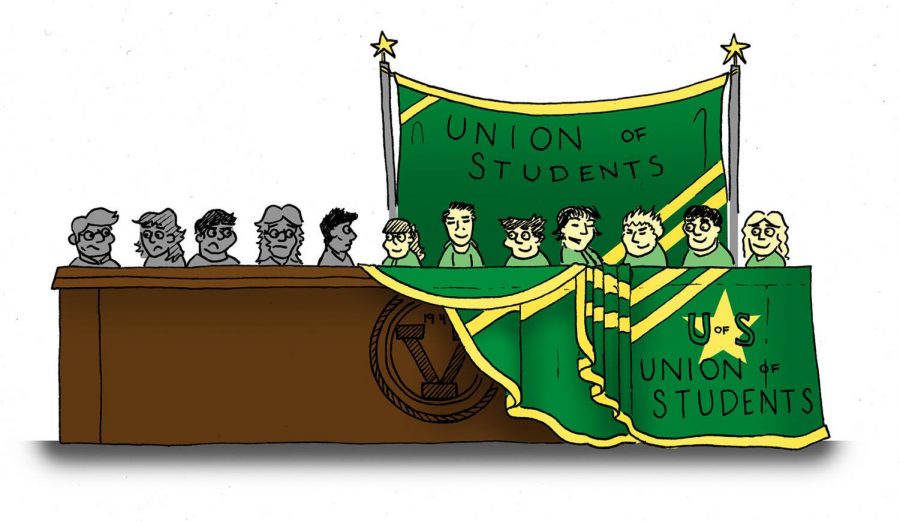Why UVM needs a student union
May 2, 2020
As a student, you have rights.
Society needs educated workers. It needs to produce scientists and doctors, writers and anthropologists, teachers and social workers. To do that, it needs students who will do the work needed to fill those roles.
The type of work we students do is intellectual work. We go to class, we think, we read and write, we conduct research, we form networks and make connections with each other and with our professors.
The product of our collective intellectual work is what makes it possible for society to have doctors, teachers, and so on. It’s what makes UVM possible. If you take anything away from that, let it be that you are a worker. And like every worker, you have rights.
The University is not respecting your rights.
We have the right to be respected and valued for the work we do as students. We have the right to a just and equitable learning process. And most importantly, we have the right to be the purposeful architects of our own education. To democratically decide how our learning should take place, and freely decide, each of us, how we will take part in it.
Now consider that every single year since 1975, the University has increased the cost of tuition. In 1975, out-of-state tuition was $2,788, but today, it is $43,690, according to the UVM Office of Institutional Research’s website . In the past five years alone, tuition has increased by nearly $6,000. In 2019, UVM made $38 million dollars in profits, according to the UVM’s 2019 Financial Report.
What has the University administration done with your money? Let’s look. According to United Academics, the UVM faculty union, only 1 out of every 3 dollars the administration spends is spent on core aspects of our education – our teachers and our classes. The rest, according to UVM’s own financial reports, is spent on “non-academic” expenses.
Among these expenses are $1 million dollars in salary for just three of UVM’s bazillion “vice presidents”, $1.6 million dollars for a “branding consultant” that UVM hired in 2016, and $3 million for that pretty, but frankly useless bridge that connects Howe Library to the Wellness Environment.
Recently, UVM announced the building of an $80 million dollar “multipurpose event center” – which, in reality, is just a marketing ploy to attract new students. Ask yourself this: if you had to choose between a fancy event building and lower tuition costs, which would you choose?
Let’s keep going. According to analysis by United Academics, based on UVM’s own salary data, between 2004 and 2012 salaries of senior administrators more than doubled by over 130%, but professor salaries only increased by 39%.
By 2016, there were 62 fewer tenure-track faculty than there were in 2007. Despite record profits, in 2017 the administration cancelled 12 courses the day before registration to “save” around $70,000, just 1/9th of Suresh Garimella’s $630,000 paycheck.
In recent years, the administration’s brutal gutting of the College of Arts and Sciences has made news. Their excuse for firing teachers and downsizing departments is that enrollment in CAS is declining, but in reality, the administration is the reason it is declining. According to another faculty union analysis of UVM financial data, in recent years, the administration has reduced the amount of CAS applicants they accept by 22 percent. Even though 40% of the student body is in CAS, only 1/11th of UVM funds go to funding the College.
The point is, UVM is rolling in (your) money, and instead of spending it on your education – they are trying to turn your right to learn into a product. And they’re doing all of this without your consent.
For a Student Union
Earlier this month, SGA elections resulted in a slate of new senators in favor of forming a student union. This is good news, but it’s making the wrong impression. There is no doubt that SGA, if used cautiously, can help achieve the goal of a student union. But make no mistake, a student union is not, I repeat – not – the same thing as SGA. And in many ways, a successful student union would make SGA obsolete.
In the most recent SGA elections, around 1,800 students voted out of 12,000 undergraduates. That’s around 15% turnout.
It’s not a mystery why SGA elections have so little turnout. Students don’t participate because they know it doesn’t really matter. They know that nothing will fundamentally change, least of all because of SGA, in the four short years they have at UVM.
The unfortunate truth is that SGA is incapable of making the change we need. To begin with, the SGA budget represents a miniscule fraction of the University’s funds, and it’s decision-making power is mostly restricted to redistributing club funds. But the problem runs even deeper.
Historically, student government associations were implemented by University administrations as a way to make students feel like they had power, without really giving them any. They were used to co-opt and kill off real student movements.
Unfortunately, our student government is no different. SGA is just a place where students get to “play” government. This is not the fault of our peers on SGA, it’s an inherent weakness in the structure of SGA itself. I’m not trying to diminish the hard work that our peers put into it, but it’s important that we are honest about the real power dynamics between SGA and the UVM administration.
Frankly, SGA does not have the power or authority to do anything that seriously challenges the administration. If we want to build real student power, SGA won’t get us there. If we want to do that, we’re going to need a student union.
Thankfully, the way a student union works is simple. It represents all of us – every student at UVM, and its job is to make sure that we, the students, are in charge of our work space. It’s made up of two parts – the general assembly, which is every single member of the union, and an organizing committee which is elected on a regular basis by the student body.
The assembly decides what the union does: what it’s goals are, and how and when it should pursue them. The job of the organizing committee is to follow through on those goals. For example, if the union is negotiating with UVM on lowering tuition costs, it’s the general assembly that decides what the terms are. The organizing committee has no ability to bargain, offer new terms, or speak for the students in any way – their job is just to communicate what the student body has decided.
The union is unabashedly pro-student. It’s not there to work “with” the administration, it’s there to defend our rights as students no matter what. It is completely independent from the UVM administration – it doesn’t need their money or their permission to do its work.
Finally, the union is based on the principle of solidarity. Solidarity means recognizing that an injustice to any of us, is an injustice to all of us. It means standing with our peers of color against white supremacy. It means having zero-tolerance for mysogny and sexual assault. It means fighting for economic justice. It means being unwaveringly feminist, anti-racist, and anti-classist, and it means centering those of us who have been on the frontlines of these struggles.
In 2012, more than 300,000 students went on strike in Quebec, Canada, just a couple of hours away from us, according to an April 2015 CBC article.75% of all college students in the province were striking, and they were led by student unions.
During that year’s state elections, the winning party won by making the demands of the student unions a part of its official platform, securing the student vote in the process, according to the same article. The combined force of the student unions enabled them not just to take on their individual university administrations, but the entire state government.
Now more than ever, we need to take inspiration from successful student movements like Quebec’s. For the past few months, our rights as students have been disrespected in an unprecedented way. Despite the transition to online classes, we are expected to pay dozens of thousands of dollars in tuition for Zoom lectures and Blackboard exams. Although negotiations with the faculty union are still underway, the UVM administration plans to fire all part time staff, cut non-tenure track salaries by 25%, and institute a hiring freeze across the board. Next year, tuition will rise. Again.
Now more than ever, we need a student union.







